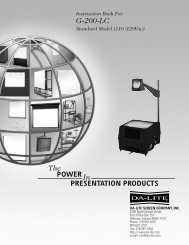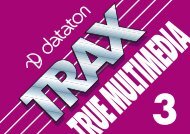Dataton WATCHOUT User's Guide
Dataton WATCHOUT User's Guide
Dataton WATCHOUT User's Guide
You also want an ePaper? Increase the reach of your titles
YUMPU automatically turns print PDFs into web optimized ePapers that Google loves.
Assembling Individual Frames<br />
Some applications, most notably 3D animation software, often save the<br />
resulting frames as individual image files. This may also be the case when<br />
scanning images frame by frame from film. Such a sequence of images must<br />
be converted into a QuickTime movie, with the appropriate frame rate, before<br />
it can be incorporated into <strong>WATCHOUT</strong>. This can be done using, for example,<br />
Adobe After Effects or Media Cleaner Pro.<br />
The individual images must be saved as files all ending in a frame number.<br />
Under Windows, this number precedes the file name extension; eg,<br />
File000.bmp, File001.bmp, File003.bmp, etc. Under MacOS, file extensions<br />
are typically not required.<br />
Assembling using Adobe After Effects. To assemble a movie from still<br />
images using Adobe After Effects, choose “Import, Footage File” on the File<br />
menu, select the first file in the sequence, and select the “ Sequence”<br />
checkbox. The desired frame rate can be specified in Preferences prior to<br />
importing the images, or can be altered at any time by choosing “Interpret<br />
Footage, Main” on the File menu.<br />
Assembling using Media Cleaner Pro. Using Media Cleaner, choose<br />
“Open Image Sequence” on the File menu and locate the first image in the<br />
sequence. Media Cleaner will prompt you for the desired frame rate.<br />
Chapter 6: Media Files 71




